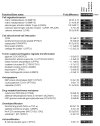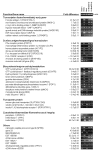Gene expression profiling following constitutive activation of MEK1 and transformation of rat intestinal epithelial cells
- PMID: 17112382
- PMCID: PMC1679808
- DOI: 10.1186/1476-4598-5-63
Gene expression profiling following constitutive activation of MEK1 and transformation of rat intestinal epithelial cells
Abstract
Background: Constitutive activation of MEK1 (caMEK) can induce the oncogenic transformation of normal intestinal epithelial cells. To define the genetic changes that occur during this process, we used oligonucleotide microarrays to determine which genes are regulated following the constitutive activation of MEK in normal intestinal epithelial cells.
Results: Microarray analysis was performed using Affymetrix GeneChip and total RNA from doxycycline inducible RIEtiCAMEK cells in the presence or absence of doxycycline. MEK-activation induced at least a three-fold difference in 115 gene transcripts (75 transcripts were up-regulated, and 40 transcripts were down-regulated). To verify whether these mRNAs are indeed regulated by the constitutive activation of MEK, RT-PCR analysis was performed using the samples from caMEK expressing RIE cells (RIEcCAMEK cells) as well as RIEtiCAMEK cells. The altered expression level of 69 gene transcripts was confirmed. Sixty-one of the differentially expressed genes have previously been implicated in cellular transformation or tumorogenesis. For the remaining 8 genes (or their human homolog), RT-PCR analysis was performed on RNA from human colon cancer cell lines and matched normal and tumor colon cancer tissues from human patients, revealing three novel targets (rat brain serine protease2, AMP deaminase 3, and cartilage link protein 1).
Conclusion: Following MEK-activation, many tumor-associated genes were found to have significantly altered expression levels. However, we identified three genes that were differentially expressed in caMEK cells and human colorectal cancers, which have not been previously linked to cellular transformation or tumorogenesis.
Figures



Similar articles
-
Constitutively active MEK1 is sufficient to induce epithelial-to-mesenchymal transition in intestinal epithelial cells and to promote tumor invasion and metastasis.Int J Cancer. 2009 Oct 1;125(7):1575-86. doi: 10.1002/ijc.24485. Int J Cancer. 2009. PMID: 19462441
-
Oncogenic potential of MEK1 in rat intestinal epithelial cells is mediated via cyclooxygenase-2.Gastroenterology. 2005 Aug;129(2):577-90. doi: 10.1016/j.gastro.2005.06.003. Gastroenterology. 2005. PMID: 16083714
-
The serine protease inhibitor serpinE2 is a novel target of ERK signaling involved in human colorectal tumorigenesis.Mol Cancer. 2010 Oct 13;9:271. doi: 10.1186/1476-4598-9-271. Mol Cancer. 2010. PMID: 20942929 Free PMC article.
-
Semaphorin-plexin signalling genes associated with human breast tumourigenesis.Gene. 2011 Dec 10;489(2):63-9. doi: 10.1016/j.gene.2011.08.024. Epub 2011 Sep 2. Gene. 2011. PMID: 21925246
-
Expression profiling of small cellular samples in cancer: less is more.Br J Cancer. 2004 Mar 22;90(6):1111-4. doi: 10.1038/sj.bjc.6601668. Br J Cancer. 2004. PMID: 15026786 Free PMC article. Review.
Cited by
-
Periovulatory expression of hyaluronan and proteoglycan link protein 1 (Hapln1) in the rat ovary: hormonal regulation and potential function.Mol Endocrinol. 2010 Jun;24(6):1203-17. doi: 10.1210/me.2009-0325. Epub 2010 Mar 25. Mol Endocrinol. 2010. PMID: 20339004 Free PMC article.
-
Systems biology approach to identify biomarkers and therapeutic targets for colorectal cancer.Biochem Biophys Rep. 2024 Jan 12;37:101633. doi: 10.1016/j.bbrep.2023.101633. eCollection 2024 Mar. Biochem Biophys Rep. 2024. PMID: 38283191 Free PMC article.
-
Activation of MEK1 or MEK2 isoform is sufficient to fully transform intestinal epithelial cells and induce the formation of metastatic tumors.BMC Cancer. 2008 Nov 17;8:337. doi: 10.1186/1471-2407-8-337. BMC Cancer. 2008. PMID: 19014680 Free PMC article.
-
Synthesis and evaluation of a novel adenosine-ribose probe for global-scale profiling of nucleoside and nucleotide-binding proteins.PLoS One. 2015 Feb 11;10(2):e0115644. doi: 10.1371/journal.pone.0115644. eCollection 2015. PLoS One. 2015. PMID: 25671571 Free PMC article.
-
Six-transmembrane epithelial antigens of the prostate comprise a novel inflammatory nexus in patients with pustular skin disorders.J Allergy Clin Immunol. 2017 Apr;139(4):1217-1227. doi: 10.1016/j.jaci.2016.10.021. Epub 2016 Nov 21. J Allergy Clin Immunol. 2017. PMID: 27884600 Free PMC article.
References
-
- Seger R, Krebs EG. The MAPK signaling cascade. FASEB J. 1995;9:726–735. - PubMed
-
- Davis H, Bignell GR, Cox C, Stephens P, Edkins S, Clegg S, Teague J, Woffendin H, Garnett MJ, Bottomley W, Davis N, Dicks E, Ewing R, Floyd Y, Gray K, Hall S, Hawes R, Hughes J, Kosmidou V, Menzies A, Mould C, Parker A, Stevens C, Watt S, Hooper S, Wilson R, Jayatilake H, Gusterson BA, Cooper C, Shipley J, Hargrave D, Pritchard-Jones K, Maitland N, Chenevix-Trench G, Riggins GJ, Bigner DD, Palmieri G, Cossu A, Flanagan A, Nicholson A, Ho JW, Leung SY, Yuen ST, Weber BL, Seigler HF, Darrow TL, Paterson H, Marais R, Marshall CJ, Wooster R, Stratton MR, Futreal PA. Mutations of the BRAF gene in human cancer. Nature. 2002;417:949–954. doi: 10.1038/nature00766. - DOI - PubMed
Publication types
MeSH terms
Substances
Grants and funding
LinkOut - more resources
Full Text Sources
Research Materials
Miscellaneous

